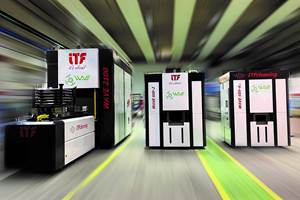For Laser Shops: Oxidation Retaliation
In an effort to prevent field paint failures, OEMs can no longer accept parts with the oxide buildup. A mechanical means of removal such as hand buffing or grit blasting is commonly practiced. However, these time-consuming and often labor-intensive processes can represent a substantial expense, and they can also introduce inconsistencies.
Share





.png;maxWidth=45)
DMG MORI - Cincinnati
Featured Content
View More


The mere mention of “scale” is enough to elicit shudders or at least a collective groan among those in the fabricating industry. That’s because they must grapple with this pest—the oxide layer formed during the laser cutting process and the resultant quality issues—each day. Compounding this issue is more stringent requirements dictated by large OEMs. In an effort to prevent field paint failures, OEMs can no longer accept parts with the oxide buildup. A mechanical means of removal such as hand buffing or grit blasting is commonly practiced. However, these time-consuming and often labor-intensive processes can represent a substantial expense, and they can also introduce inconsistencies.
“The layer formed during the laser cutting process manifests itself as a loosely adhering scale that easily chips and cracks from the metal surface upon impact,” says Tom Fabek, vice president of sales and marketing at Chemical Methods, a Cleveland, Ohio-based developer of surface treatment chemicals, metalworking fluids and corrosion inhibitors. “Therefore, its removal is necessary before painting. Otherwise, adhesion failure, customer complaints and warranty claims will result.”
When a part is lightly bumped or jostled, the laser scale and paint can flake off. Even slight impact can create a naked edge that is susceptible to corrosion. Mr. Fabek adds that aside from costs, these manual buffing and blasting methods are subjective—areas can be overlooked because of operator inattention.
“Although the edges may grind off relatively easily, it’s impossible to reach those nooks and crannies, especially small holes, with a grinding tool,” he says.
Consequently, a growing number of fabricators and finishers are implementing chemical cleansers in automated washing systems, such as tunnel washers.
Got Chemistry?
During the cutting process, a reaction between the oxygen and the iron inherent to the metal creates a layer of iron oxide. Referred to as “scale,” this is something different from that familiar red rust. The scale is inorganic, so conventional alkaline cleaners cannot dissolve it. Acid-based cleaners, on the other hand, will do the trick.
A combination of acids, surfactants and other raw materials comprise acid-based cleaners. Sulfuric acid-based cleaners are too harsh and can damage equipment, whereas phosphoric acid is less toxic and suitable for use in this application, says Mr. Fabek. Chemical Methods offers a phosphoric acid-based cleanser that dissolves inorganic and organic substances in one step to preserve part cleanliness. The acid portion of the cleaner removes the oxide layer and any other inorganic soil, while the surfactants and other raw materials remove oils and organic soils. This two-prong approach is beneficial because shops can implement this one fluid to get rid of not just the scale, but also the greases and oils that can accumulate on the piece during bending, forming or stamping.
One potential user is the Case New Holland (CNH) plant in Belleville, Pennsylvania. It specializes in hay and forage equipment, employing CO2 lasers to cut sheet metal. The plant acknowledges that the oxide scale that accumulates on its parts is a major concern.
“Every part we cut has scale on it,” says John Shoemaker, manufacturing engineer at the CNH facility.
Though CNH has begun exploring phosphoric acid-based cleansers as a substitute to its current method—manually removing the affected areas with a grinding wheel—the company has no formal plans to implement a chemical cleanser. The reason relates to the new equipment that would be required. Indeed, both Mr. Fabek and Mr. Shoemaker acknowledge that there are various considerations to be weighed, such as:
Capital Investment—If stainless steel or polypropylene washers are not already in place, then it is imperative that such equipment be purchased, as milder steels cannot withstand the causticity of acid-based cleaners.
Safety Precautions—Make sure that the area is well ventilated when introducing the chemical element.
Operator Training—Not entirely a pushbutton solution, the process does require some knowledge on the part of shop personnel. Mr. Fabek advises personnel to be mindful of the recommended process parameters defined for the wash line. These include temperature, cleaner concentration, spray impingement and proper parts hanging so that all laser edges are exposed to the cleaner.
Referring to chemical processing, CNH’s Mr. Shoemaker says, “We’re heading to the day we’ll have to do it to stay in business. The industry is anxious for an answer to this problem.”
Related Content
Alliance Manufacturing's Cleaning Systems Use Safe Solvents
PMTS: The company’s vacuum degreasing machines use solvents to remove contaminants from manufactured parts without the use of water or scrubbing.
Read MoreMadison Chemical Degreaser Easily Removes Machining Oil
ProClean Degreaser quickly and completely removes oil and grease with its superior wetting and penetrating properties.
Read MoreNMP's Parts Cleaning Systems Pass Upcoming Regulations
PMTS 2023: ITF Parts Washing Equipment machines are designed to help prepare and sustain manufacturers for the upcoming environmental regulations in North America.
Read MoreVollmer Ultrasonic Cleaning, Deburring System Provides Process Reliability
IMTS 2024: The UltraTec Ultrasonic A25 cleans and deburrs small and delicate components, making it well suited for applications in heavily regulated sectors with challenging demands.
Read MoreRead Next
Building Out a Foundation for Student Machinists
Autodesk and Haas have teamed up to produce an introductory course for students that covers the basics of CAD, CAM and CNC while providing them with a portfolio part.
Read More5 Rules of Thumb for Buying CNC Machine Tools
Use these tips to carefully plan your machine tool purchases and to avoid regretting your decision later.
Read MoreRegistration Now Open for the Precision Machining Technology Show (PMTS) 2025
The precision machining industry’s premier event returns to Cleveland, OH, April 1-3.
Read More


.png;maxWidth=150)


































.jpg;maxWidth=300;quality=90)

.jpg;maxWidth=300;quality=90)









